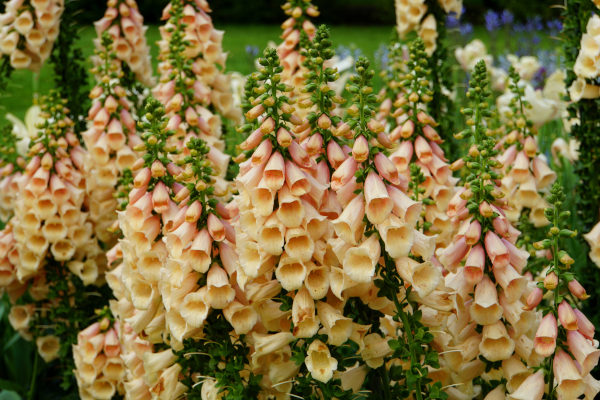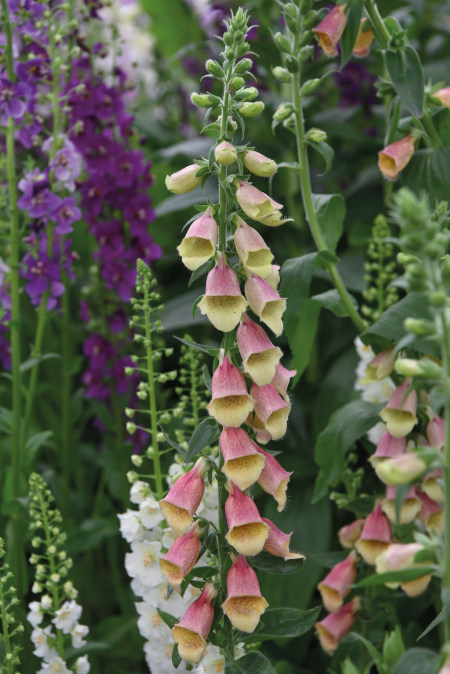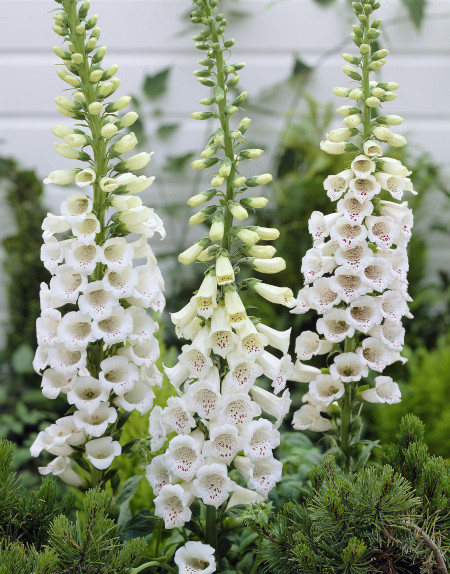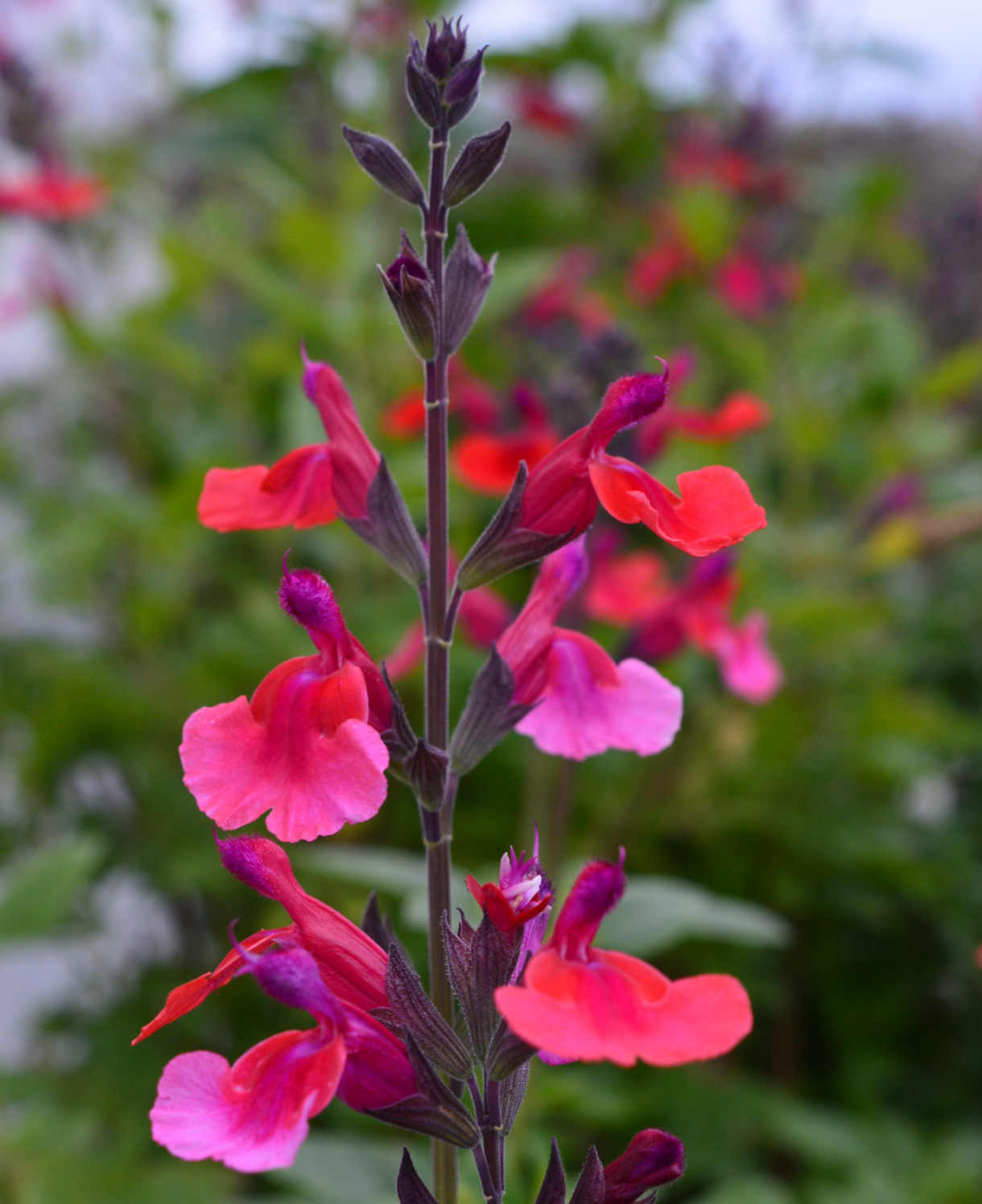How to grow Digitalis
This instantly recognisable plant can be biennial or short-lived perennial, depending on the species. It is grown for its striking spires of tubular, bell-shaped flowers (often spotted inside), borne in tall, sometimes branched, usually one-sided racemes. These emerge from basal leaf rosettes, with smaller leaves usually found on the stem.
Our native digitalis, Digitalis purpurea, is a familiar sight throughout hedgerows and woodlands, its purple and occasionally white flowers a valuable source of food for long-tongued bumblebees. Like most digitalis, it is a woodland plant and grows best in dappled shade, though there are some species (such as D. parviflora and D. obscura) which prefer full sun. With many species and cultivars available, there is a kaleidoscopic range of colours to choose from.
Digitalis is also known by the common name, foxglove.

Zantedeschia is a genus of flowering plants from the family Araceae and is native to southern Africa. With a rich history dating back to the Ancient Romans, these deciduous or semi-evergreen perennials have been used as a symbol of celebration. Zantedeschia was Named after Professor Giovanni Zantedeschia, an Italian botanist.
There are two main forms of Zantedeschia: hardy and tender. Hardy forms of the plant can be grown outdoors, enjoy moist soil and full sun or partially shaded conditions - these are known as Arum lilies. Tender forms of Zantedeschia prefer being grown in containers or pots and should be brought inside over the winter - these are known as Calla lilies.
With tuberous flora in all colours from whites, yellows and oranges to deep reds and purples, Zantedeschias are not to be overlooked in any garden, as long as they have sufficient sunlight to grow in.
Ready to learn more about growing Zantedeschia? Read on for all there is to know...

Key Information
Soil pH
Position
Hardiness

Horticultural Divisions-
Species | Lifespan | Aspect | Flowering period | Hardiness | |||
Biennial | Short-lived perennial | Full sun | Partial shade | Full shade | |||
Digitalis ferruginea | ü |
| ü | ü | ü | Summer | H6 (-15°C to -20°C) |
D. grandiflora |
| ü | ü | ü | ü | Summer | H6 (-15°C to -20°C) |
D. lutea |
| ü | ü | ü | ü | Summer | H6 (-15°C to -20°C) |
D. obscura |
| ü | ü | ü |
| Summer to early autumn | H4 (-5°C to -10°C) |
D. purpurea | ü |
| ü | ü |
| Late spring to early summer | H7 (-20°C and beyond), though some cultivars can be less hardy. Check! |
D. x mertonensis | ü |
| ü | ü |
| Summer | H5 (-10°C to -15°C) |
D. x valinii |
| ü | ü | ü |
| Summer to early autumn | H3 (1°C to -5°C) |
D. parviflora |
| ü | ü | ü | ü | Summer | H5 (-10°C to -15°C) |
D. lanata |
| ü |
| ü |
| Summer | H5 (-10°C to -15°C) |

Where & when to plant Digitalis
Position - Full sun to full shade, depending on the species
Soil - Most prefer humus-rich, moist, well-draining soil, however will grow in almost any soil except for the extremes of very wet or very dry. Acid, alkaline, or neutral.
Flowering Period - Spring/ summer depending on the species
Hardiness - hardiness can vary depending on the species
For best results, plant in autumn or spring. An autumn planting can be done by those gardening in mild conditions (and broadly speaking, this is the southern half of the UK). For those liable to cold winters, it is best to wait until spring (generally the northern half of the UK). Planting can also be carried out in summer, though be prepared to water regularly. It is worth noting that biennial species flower in their second year, so, depending on when you buy and plant them, may not flower until the following growing season. If you want your digitalis to self-seed and bloom in the garden every year, you will need to plant new plants two years running.
Most species of digitalis are tall and imposing, so suit the middle to back of a border. Traditionally they have been a favourite in informal, cottage garden style schemes or woodland gardens, though fit equally well in more contemporary styles, particularly some of the more unusual species and cultivars. While they grow best in the ground, digitalis may also be grown in a container. Try some of the dwarf forms for this, such as D. ‘Dwarf Carillon’, D. ‘Goldcrest’, or D. ‘Silver Cub’.
How to plant Digitalis
Try to position digitalis at least 30cm apart, as inadequate room for their foliage to spread out can cause a year’s delay in flowering
- For planting in the garden, dig the soil area removing any large stones and weeds and breaking up any lumps. Mix in some organic matter such as manure or garden compost. If your soil is heavy clay, now is also the time to add a generous helping of horticultural grit. Rake level and firm with your heels. Rake level again.
- Water plants well and allow to drain before planting.
- A good tip is to dig a hole twice the size of the root-ball. Fill with water and allow to drain before placing in the plant.
- Place the plant in the hole, ensuring the top of the root ball sits level with the surface of the soil. Too low and the plant may rot, too high and the roots can dry out.
- Backfill with soil and firm in gently with your foot.
- Soak well with water.
- Mulch around the base with well-rotted organic matter.
- For planting in containers, first choose an appropriately sized pot. You may wish to grow digitalis on its own in a pot just a few centimetres larger than the rootball, or as part of a larger, mixed container display. Either way, ensure there are plenty of drainage holes in the bottom.
- If you are using a large or heavy pot, it can be a good idea to fill and plant it in situ to save yourself the trouble of moving once full.
- Use a good quality potting compost with plenty of horticultural grit mixed in, and, if not already present in the compost (check the description on the bag) some slow-release fertiliser granules.
- Start by partially filling the pot with compost; enough so that when placed on it the upper surface of the root ball is about 3cm lower than the top of the pot.
- Infill all the space surrounding the root ball with compost, firming down with your fingers then adding a little more so the plant is held tight.
- Pick up the container and lightly tap on the potting bench or ground a few times to help further settle the compost around the plant.
- Soak well with water.
- A mulch with horticultural grit will look attractive and help to prevent a ‘cap’ or crust forming on the top of the compost (something container plants can suffer due to the artificial nature of their watering).

What to plant with Digitalis
Combine the upward brush strokes of digitalis with other, varied flower forms for a pleasing, professional-looking planting scheme. Think the flat umbels of orlaya and achillea, the open, daisy-like blooms of dahlia and leucanthemum, the rounded globes of allium and agapanthus, and the smaller, delicate textures of geranium, salvia, and phlox. Throw in some grasses such as pennisetum or miscanthus to complete the designer border!



How to care for Digitalis
Pruning and Deadheading
Deadhead digitalis after flowering to encourage a second flush. If you want your plants to self-seed around the garden, leave a few spent flower stems intact.
Biennial species can be removed to the compost heap in late autumn/ winter (try to leave them until this point to ensure self-seeding, if this is what you want).
Perennial species can be cut back to just above the basal rosette of foliage. As above, delay this until late in the year if you wish to encourage self-seeding. In the spring, give a light tidy, removing any tatty, yellowed foliage.
Watering
During the first few months of their first growing season in the ground, a good soaking every couple of weeks should ensure long-term success (aiming for consistently moist, but not soggy soil). After this, digitalis tends to be self-sufficient. An annual mulch will help lock moisture into the soil (see also ‘Feeding’ section below).
Container-grown digitalis needs to be watered regularly throughout the growing season. Allow the top few centimetres of compost to dry out between soakings (check this with your finger).
Feeding
On healthy, fertile soil, an annual mulch of well-rotted organic matter (i.e., a layer of manure or garden compost applied to the soil around the plant) should provide sufficient nutrients for your digitalis. This has the added benefit of suppressing weeds and locking in moisture.
If yours looks in need of an extra boost (perhaps you garden on poor soil), applying a general purpose granular feed to the surface of the soil and lightly working in (known as a ‘top dress’) can reap benefits. Aim to do this in spring, and then again in midsummer if needed. Resist the urge to feed any more than this, as the results can encourage powdery mildew (explained below).
Container-grown plants rely more on the gardener for their nutritional needs. Get off to a flying start by making sure you use a good quality compost, then throughout the growing season (March to September) apply a liquid feed at regular intervals according to its instructions. Alternatively, top dress with a general purpose granular feed every three months throughout the growing season.
Cold Protection
The hardiness of digitalis can vary considerably, so do make sure you check each individual species or cultivar so you can plan accordingly.
Anything rated H4 or higher should cope with an average UK winter without the need for additional protection. If you live in a very cold region, or are growing a digitalis rated H3 or lower, we recommend taking precautions to prevent winter losses. This might be a cloche or some horticultural fleece placed over the top growth, or a thick layer of dry, insulating mulch around the roots (straw, bracken, or bark chippings are suitable).
Move less hardy, container-grown digitalis to a protected place such as a cool greenhouse or conservatory if you have one of these. Otherwise, cover the top growth with fleece, wrap the container in bubblewrap or hessian sacking, and move to a sheltered spot such as against a south-facing wall.
Remember that winter waterlogging can reduce the hardiness of a plant, so do take care to avoid areas prone to this when planting.
Pests and Diseases
Digitalis tends to be largely problem free, though can occasionally succumb to powdery mildew, and may get munched by slugs and snails (particularly when the growth is young and tender in spring).
Powdery mildew is a fungal disease that can appear as a white, powder-like coating on leaves, stems, and flowers. It can be caused by poor air flow, drought stress, or insufficient sunlight. Prune off and dispose of any affected leaves, keep plants well-watered (avoiding water on the foliage if possible), and if necessary, thin out surrounding plants to improve airflow. Do not over feed, as this will generate an excess of soft, new growth which is particularly susceptible.
When it comes to slugs and snails, encouraging natural predators into your garden, such as birds, frogs, toads, and hedgehogs, will make a big difference. Torchlight searches after dark (when slugs and snails are at their most active) are also effective, allowing you to collect the offending molluscs in a bucket and dispose of as you see fit. Relocating to a nearby woods or bagging up and putting in your freezer before popping them in the bin are said to be the most humane approaches.
How to propagate Digitalis
Most species of digitalis will self-seed readily, meaning the quickest and easiest way to ensure an ongoing presence in your garden is to simply do nothing! Leave spent flowers intact and remember to look out for seedlings when weeding or hoeing in spring.
Some cultivars or hybrids (E.g., D. purpurea ‘Pam’s Split’ or D. x mertonensis) produce little or no seed, so you’ll need to buy new plants to replace these.
If you wish to collect and sow seed yourself, follow these simple steps:
- Seeds are typically ready for collecting in late summer when the seedheads have dried and turned brown.
- Snip the seedheads from the plant using scissors or secateurs. Try to do this in dry conditions, and place in a small paper bag or envelope.
- Fill a seed tray or small pot with a very well-draining compost mix, compressing the surface lightly with a flat piece of wood or the bottom of another pot.
- Sprinkle the tiny seeds evenly over the surface of the compost, pressing down lightly to ensure contact.
- Digitalis seeds germinate best when left uncovered, so don’t sprinkle any compost on top as you would usually with seed sowing.
- Water the soil gently with a fine spray until it is evenly moist but not waterlogged.
- Place the seed tray or pots in a coldframe, unheated greenhouse, or on a cool, bright windowsill.
- When the seedlings have grown large enough to handle, transplant them into individual pots filled with a very gritty mix and continue to grow on in a frost-free environment.
- Keep barely moist, never soggy.
- Plant out the following spring, following our ‘How to plant digitalis’ section above.
* Many plants carry Plant Breeders Rights and cannot be propagated for commercial purposes.
Common Digitalis Questions
- Is digitalis easy to grow?
Very! Providing you get your head around the winter care requirements of your individual species and understand its lifespan, digitalis is an easy-going, hassle-free, rewarding plant to grow. - Do foxgloves come back every year/ how many years do foxgloves last?
Biennial species will put on leaves in their first year, then flower, set seed, and die in their second year. Most species will perpetuate themselves by self-seeding (as long as you leave the flowerheads intact), though there will be a two year wait for flowers each time. For flowers every year, you will initially need to plant new plants of biennial species two years running.
Perennial species will come back again after their second year, though these do tend to be fairly short-lived and rarely last more than a few years. You’ll see when they are starting to tire – there will be fewer flowers and less overall vigour. When you spot this, it is time to collect seeds for fresh, new plants to start again with the following year. Without adequate winter protection, less hardy species may have their expected life cycle cut short by exposure to the cold and wet.
- How poisonous is foxglove?
All parts of digitalis are highly toxic if ingested and can kill an adult human. Possibly one to avoid if you have pets or children.
- What do you do with foxgloves once they have flowered?
To encourage self-seeding, leave spent flowerheads on the plant until winter/ spring. After this, biennial species can be removed to the compost heap, and perennial species cut back to the base.





